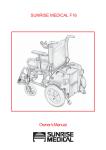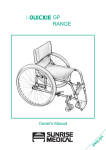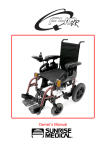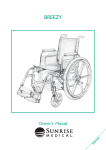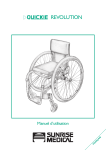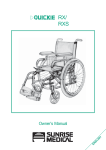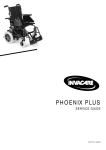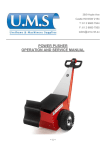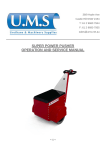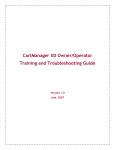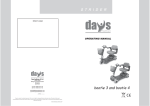Download Sunrise Medical F45 User's Manual
Transcript
F45 Owner’s Manual SH I L G N E F45 Issue 6 62 F45 How to use this manual We at Sunrise Medical want you to get the best out of your F45 wheelchair. This Owner’s Manual will familiarise you with the chair and its features. It contains hints on everyday usage and general care in addition to information on the high quality standards which we adhere to and details about the guarantee. There are a wide range of components and adjustments available on the F45 for further information about these you should contact your wheelchair prescriber/supplier. Your wheelchair will reach you in excellent condition having been personally inspected before leaving our factory. By following the guidelines for maintenance and cleaning your wheelchair will maintain its first class condition and give you complete satisfaction. F45 Issue 6 60 Contents Introduction page 1 Guarantee page 2 Features and options page 3 Safety warnings and user tips page 4 - 6 Preparing your wheelchair for use page 7 - 8 Emergency freewheel page 9 Dedocking page 9 - 11 Armrests page 12 Footrests page 13 - 14 Seating page 15 - 19 Penny & Giles control pod page 20 - 26 Proportional control page 27 - 29 Parallel swing away arm page 30 Kerb climber page 31 - 33 Batteries and charging page 34 - 43 User tips page 44 - 46 Transportation page 47 - 48 Lap belt instructions page 49 - 51 Maintenance and service history page 52 - 54 Sunrise Medical page 55 61 F45 Issue 6 Introduction The F45 has been designed for use by an individual on a daily basis. It is suitable for both indoor and outdoor use. It is only intended for use as a pavement vehicle, but may also be used when crossing between pavements. This vehicle has been designed for a single occupant of limited mobility up to the weight of 118Kg who has the cognitive, physical and visual ability to control the vehicle safely. If you are in any doubt as to the suitability of the powerchair, contact your local Sunrise approved dealer for clarification, prior to commencing use. It is very important to read the relevant section of the owners manual when making any adjustments. If you have any queries about the use, maintenance or safety of your wheelchair please contact your local approved Sunrise Medical service agent. If you do not know of an approved dealer in your area or have any other questions please write or telephone: SUNRISE MEDICAL LIMITED SUNRISE BUSINESS PARK HIGH STREET WOLLASTON WEST MIDLANDS DY8 4PS ENGLAND Telephone 01384 44 66 88 Fax. 01384 44 66 99 International Telephone +44 1384 44 66 88 Fax.+44 1384 44 66 99 www.sunrisemedical.co.uk Sunrise Medical is ISO 9001 certified, which ensures quality at all stages of the development, and production of this wheelchair. This product is manufactured to comply with the radio interference requirements of EEC directive 89/336/EEC Medical Device Directive 93/42/EEC Sunrise is dedicated to providing products of exacting quality which conform fully and reliably to the requirements of their intended use. Sunrise is accredited to B.S. EN ISO 9001 which is the internationally recognised standard for quality management systems. This approval ensures we provide quality in all areas of our business from development through to final delivery. SERIAL Number: INSPECTED BY: 1 F45 Issue 6 Guarantee 7) The above warranty conditions apply to all wheelchair parts, for models purchased at full retail price. Your guarantee The guarantee form is included in the Sunrise Pack, please fill in the relevant details and return to us to register your entitlement. 8) Under normal circumstances, no responsibility will be accepted where the wheelchair has required repair or replacement as a direct result of:- THIS IN NO WAY AFFECTS YOUR STATUTORY RIGHTS. a) The wheelchair or part not having been maintained in accordance with the manufacturer’s recommendations, where such exist. Or failing to use only the specified original equipment parts. Warranty conditions 1) The repair or replacement will be carried out by an authorised Sunrise Medical dealer/service agent. b) The wheelchair or part having been damaged by neglect, accident or improper use. 2) To apply the warranty conditions, should your wheelchair require attention under these arrangements, notify the designated Sunrise Medical service agent immediately giving full information about the nature of the difficulty. Should you be operating the wheelchair away from the locality of the designated Sunrise Medical service agent work under the “Warranty Conditions” will be carried out by any other service agent designated by the manufacturer. c) The wheelchair or part having been altered from the manufacturer’s specifications, or repairs having been attempted prior to the service agent being notified. Please keep a note of your local service agent’s address and telephone number in the space below. In the event of a breakdown, contact them and try to give all relevant details so they can help you quickly. 3) Should any part of the wheelchair require repair or replacement, as a result of a specific manufacturing or material defect, within twelve months from the date on which the possession of the wheelchair was transferred to the original purchaser, and subject to it remaining within that ownership, the part or parts will be repaired or replaced completely free of charge if returned to the authorised service agent. The wheelchairs shown and described in this manual may not be exactly the same in every detail as your own model. However, all instructions are still entirely relevant, irrespective of detail differences. The manufacturer reserves the right to alter without notice any weights, measurements, or other technical data shown in this manual. All figures, measurements, and capacities shown in this manual are approximate, and do not constitute specifications. Note: This guarantee is not transferable. 4) Any repaired or replaced part will benefit from these arrangements for the balance of the warranty period applicable to the wheelchair. Your local dealer 5) Parts replaced after the original warranty has expired are covered for a further twelve months. 6) Items of a consumable nature will not generally be covered during the normal warranty period, unless such items have clearly suffered undue wear as a direct result of an original manufacturing defect. These items include amongst others upholstery, tyres, inner tubes, and similar parts. Your local dealer Sunrise Medical Limited High Street, Wollaston, West Midlands DY8 4PS England Tel 01384 44 66 88 Fax 01384 44 66 99 www.sunrisemedical.co.uk Please remember to fill in and post the guarantee registration card enclosed with this manual. Sunrise Medical Limited recommend that you do not undertake maintenance tasks other than those explained in this manual. Your local approved Sunrise Medical service agent is fully trained by Sunrise Medical to carry out detailed maintenance as and when required. Use only genuine Sunrise Medical replacement parts. F45 Issue 6 2 Features and options Backrests page 16-19 Armrests page 7,12 Seating page 15 Control box page 20-29 Batteries and Charging page 34-43 Footrests page 13-14 Emergency Freewheel page 9 Tyres page 52 Kerb Climber page 31-33 The F45 has been designed for use by an individual, on a daily basis. It is suitable for both indoor and outdoor use. It is only intended for use as a pavement vehicle, but may also be used when crossing between pavements. This vehicle has been designed for a single occupant, of limited mobility, up to the weight of 118Kg, who has the cognitive, physical and visual ability to control the vehicle safely. If you are in any doubt as to the suitability of the powerchair, contact your local Sunrise approved dealer for clarification, prior to commencing use. Some of the options shown in this manual may not be available in your country. For further information please consult your Sunrise supplier. 3 F45 Issue 6 Safety warning and user tips Emergency freewheel Safety is a very important with any vehicle that is power driven, here are some helpful tips to safeguard your use. Please remember that you have no braking facility when the freewheel lever is moved from the normal drive position to the freewheel position. General Always ensure that your wheelchair is switched off before attempting to mount or dismount. Always ensure that you are able to operate all controls from a comfortable position. Paying attention to your posture is essential to ensure your continued comfort and well being. Always make sure that you can be seen clearly, especially if you intend using your wheelchair in poor light. The wheelchair must never be left with the lever in the freewheel position. For a fuller description of this facility and its limitations to use please see later section. Emergency braking The simplest and safest way to stop the wheelchair is to release the joystick control lever (see Control pod section). This will bring the chair to halt in a controlled manner. Kerbs Never descend a kerb Forwards. Please read carefully the section on kerb climbing in this manual before attempting to mount and dismount any kerbs in your wheelchair. Do not attempt to climb or dismount a series of steps. It is unsafe to do so and could cause personal injury or damage the chair. The F45 has only been designed to climb a single step or kerb Switching the control system off whilst the chair is in motion will also bring the chair to a halt. This latter method is not recommended as the stopping action is very abrupt. Sharp turns Full speed turns should not be attempted. If you need to turn sharply you must reduce your speed with the joystick or speed setting. This is particularly important when travelling across or down a slope. Disregarding this advice could lead to your wheelchair tipping over. Routine service Like most things in life a little care and attention goes a long way and your chair is no exception. The recommended service interval is one year. (See service history on page 43). F45 Issue 6 4 Safety warning and user tips Batteries Tyres Your wheelchair is supplied as standard from Sunrise Medical with maintenance-free batteries. These only require regular charging. Your wheelchair tyres can wear depending on use. Check them regularly in accordance with the service instructions in this manual, especially the pressure of the tyres. Do not, under any circumstances, tamper with the batteries. If in any doubt contact your local service agent. NEVER inflate the tyres using a garage forecourt airline, always use the pump provided. Do not connect the battery charger to the mains supply until after you have connected the charger to the wheelchair. Before charging, please read the relevant section in this manual. Take care with battery acid which is very dangerous. It can cause burns to the skin as well as damage to floors, furniture and your wheelchair. If it comes into contact with the skin or clothing, wash immediately with soap and water. If it comes into contact with the eye, immediately flood the eye with running cold water for at least 10 minutes and seek medical attention immediately. Acid can be neutralised with baking soda and water. Take care to keep batteries upright at all times, especially when transporting your wheelchair. Cleaning seating This is important should the wheelchair be used by more than one person to ensure there is no cross infection. Cleaning controls Should the control of your wheelchair become soiled or dirty, it can be wiped with a damp cloth with a dilute disinfectant until clean. This is important should the wheelchair be used by more than one person to ensure there is no cross infection. Wheelchair motors After prolonged use, the motors will produce heat which is radiated through the motors outer casing. Do not touch the motors outer casing for at least 30 minutes after using the wheelchair, to allow it to cool. Note: Before using your vehicle for the very first time, please charge your batteries for a period of 24 hours. 5 F45 Issue 6 Safety warning and user tips Use on a slope (continued) Wheelchair range Failure to do this may cause the wheelchair to become unstable. If you are in any doubt about the capabilities of wheelchair on a slope then do not attempt to drive up or down the slope, try to find an alternative route. The range of your wheelchair can be affected by many factors such as user weight, terrain, ambient temperature and battery condition. The stated range in the sales literature should be seen as the theoretical maximum and may not be attained by every user. Mobile telephones and two way radios. We recommend that every user initially limit their journey to half the stated range, until they have confidence in the actual range their wheelchair can attain. If your battery indicator is showing a low charge then do not attempt a long journey unless you are confident in reaching your destination and also returning to your home without the risk of being left stranded. When operating cordless or mobile telephones, two way radios, walkietalkies, C.B. Amateur Radio or other transmitting devices, the following must be noted: Mobile telephones or two-way radios devices must not be used while operating the vehicle. Use of Mobile Phones or Two Way Radios can cause excessively strong electromagnetic fields. This may interfere with the vehicles electronic systems. If Mobile Phones or Two Way Radios are required to be used, the vehicle must be brought to a halt and the power turned off before any such device is switched on or used. Use on a slope Your wheelchair has been designed and tested to allow its use on slopes or gradients of up to 1 in 4 (25%). However, if you have the option of adjusting the angle of seating with either tilt seat or recline back, then in certain circumstances your wheelchair could become unstable. Before attempting to climb or decline a slope, we strongly recommend that you return the seat and back to an upright position. F45 Issue 6 6 Preparing your wheelchair for use Armrests-removing Fig 1a: The armrests on both sides of the wheelchair can be removed to allow side transfer. Press the spring loaded catch mounted on the side of the armrest frame down tube (Fig. 1a) and remove armrest as shown. When seated, lower the armrest until it locks into the retaining bracket. For full details see later pages. Fig. 1a Armrest spring loaded catch Fig 1b: Turn handle left to loosen the armrest. Move the tubes of the armrest out of the receptor tubes. Fig. 1b Armrests-replacing Fig 2a: To replace the armrests, locate the slots over the location pivot as shown in Fig. 2a and push the armrest to a vertical position until you feel it lock automatically into place. Prior to use ensure the Armrest is securely locked in place. Fig. 2a Fig 2b: Insert the tubes of the armrest in the receptor tubes and turn handle right to fix the position. Fig. 2b 7 F45 Issue 6 Preparing your wheelchair for use Fitting footrests Fig.3a Firstly, offer the footrest assembly at right angles to the frame (Fig. 3b), locate the stem into the frame tube and swing the assembly forward as in Fig. 3a to lock in position. To swing away the footrest, simply depress the retaining catch and turn the footrest out. This can now be lifted out if required. Fig. 3 Control box Control pod slide Fig 4a: Connect the power lead to control box (Fig. 4a). The control box is mounted on a sliding mechanism which enables the control to be moved forwards and backwards. When the most comfortable position has been selected, secure the slider by tightening the locking screw. Ensure the locking screw is fully tightened prior to use and especially when transporting your wheelchair. Fig. 4a Fig 4b: You can slide the control along the rail and set as you wish. To adjust the control arm rotate handle, located under the rail to the left. Turn to the right to fix the position. F45 Issue 6 Fig. 4b 8 Locking screw Emergency freewheel and dedocking Emergency freewheel By turning the drive handles outwards (Fig. 5), the drive becomes disconnected from the motors. This may only be used in an emergency, or if you need to manually push your wheelchair. It is not intended for permanent use. REMEMBER: The chairs automatic braking system will not work unless the handles on both gearboxes are turned inwards. ALWAYS RE-ENGAGE THE EMERGENCY FREEWHEELS AFTER USE Drive handles in ‘drive’ position Fig. 5 Dedocking procedure Joystick On/off button Some models may be equipped with a motor dedocking facility: To dedock the motors follow the procedure given below: 1. Ensure the power is switched off at the control pod (Fig. 6). Note both types of control pod On/Off switches are illustrated. 2. Disengage the drive levers following the procedure above (Emergency freewheel - Fig. 5). On/Off Switch Fig. 6 9 F45 Issue 6 Dedocking 3. Disconnect the power lead 6 pin plug from the rear battery (Fig. 7). Lift and pull the battery basket rear handle to gain access to the batteries. Disconnect the battery connection plug. Depress the buckle lock to release the rear battery and lift the battery out. Unlock the retaining strap on the front battery and lift it out. 4. Remove the battery basket. 5. Disconnect the motor power supply plug (Fig. 7). 6. Lift and tilt the chair (Fig. 8), grip the drive unit handle and push down the dedocking trigger and at the same time gently ease the chair away from the motor unit. Move the motor unit away from the chair and repeat the process on the other motor. 6 pin connector Battery connection plug Rear handle Rear runners Fig. 7 Fig. 8 F45 Issue 6 10 Dedocking Refitting motor drive units 1. To refit the motor drive units ensure the 6 pin plug power connectors are free. 2. Tilt and lift the locating tongue under the dedocking socket. Lower the chair until the dedocking trigger clicks into position (Fig. 9). 4. Reconnect the motor drive unit 6 pin power plugs. 5. Fit the battery basket and the batteries, ensuring that the batteries are correctly secured with the retaining straps. 6. Connect the batteries with the connection plug, slide the battery basket into its forward postion, ensuring that it locks positively over its location studs and finally connect the 6 pin power plug to the rear battery socket (Fig 10). 7. Ensure the freewheel levers are in the drive position. Fig. 9 6 pin connector Battery connection plug Ensure the levers are in the drive position Fig.10 11 F45 Issue 6 Armrests Adjusting the armrest width To adjust the width loosen the two screws as shown in Fig. 11, move the armrest assembly to the desired position, and tighten the screws firmly prior to use. Width adjusting screws Fig. 11 Adjusting armrest height Fig 12a: To adjust the height loosen the adjusting screw, move the armrest to the desired position and tighten the screw. Fig 12b: Turn the handle to the left to free the tube of the armrest. Raise as you wish, and then turn the handle to the right to fix the position. Armrest height adjusting screw Fig. 12a Fig. 12b F45 Issue 6 12 Footrests Footrest The footrest assembly can be removed by pulling the release lever forwards and swinging the footrest outwards and upwards. To re-fit the footrest insert the top into the vertical tube and swing inwards until the release lever locks into place (Fig. 13). Footrest release lever Fig. 13 Adjusting the footrest angle To adjust the angle simply loosen the screw on the knuckle joint. Move the footrest lower section to the desired position and tighten the screw (Fig. 14). Footrest angle adjustment screw Note: Ensure the serrations in the knuckle joint are correctly aligned prior to tightening the screw, and that the screw is firmly tightened prior to use. Fig. 14 13 F45 Issue 6 Footrests Adjusting the footrest length Footplate length adjustment screw assembly To adjust the footrest length remove the screw assembly on the footrest stem as shown in Fig. 11, adjust the length to suit. Replace the bolt assembly and tighten. Ensure the bolt is firmly located and tightened prior to use. Note: The internal footrest stem may require cutting down in length to allow the footplate position to be raised (Fig. 15). Internal footrest stem Footplate Fig. 15 Footplates The footplates may be flipped up to aid entry and exit from the chair. (Fig. 16). Do not use the footplates to stand on as the full weight of your body may cause the chair to tip forwards and damage the footrests. Footplates in raised position Fig. 16 F45 Issue 6 14 Seating Seat sling tension adjustment Loosen all the screws The seat upholstery may be retensioned. To do this, loosen all the screws as shown in Fig. 17 and detach the Velcro® . Re-tension the seat, attach the Velcro® and securely tighten the screws. Firm seat board The optional Firm Seat Board is designed to allow pressure relief cushions such as Jay to be used. If Retro-fitting the firm seat board you must ensure the two retaining screws and collars are fitted and that the seat hooks are located behind them prior to use (Fig. 18). Failure to do this may result in the seat tipping up and possibly causing injury. Detach the Velcro® Fig. 17 Seat cushions Seat cushions supplied by Sunrise Medical will have Velcro® strips that correspond to patches on the seat. You must ensure these are aligned prior to using the wheelchair. Other cushions used should also have Velcro® strips in a similar position to ensure the cushion does not slip off the seat. The seat cushion supplied by Sunrise Medical all have removable covers. Velcro® strips Ensure the seat hooks are correctly located Fig. 18 15 F45 Issue 6 Seating Backrest removal and refitting Although there are a variety of backrests which can be used on the F45 chair they all attach and release in the same way. To remove the backrest (Fig. 19) depress the two catches on the base of the backrest and pull up the back. To attach the backrest repeat the process in reverse. You must ensure the two catches are securely locked in position and the backrest is correctly and firmly attached prior to using your chair. Fig. 19 Optima backrest upholstery The F45 can be supplied with optima backrest upholstery (Fig. 20) which can be adjusted to the individual’s requirements. Fig. 20 F45 Issue 6 16 Seating Changing the shape or tension Loosen or tighten the straps to suit the user’s need To change the shape and/or tension of the ‘Optima’ backrest remove the padded cover from the rear of the backrest and expose the tension straps (Fig 21). Loosen or tighten the straps to suit. (The most comfortable and supportive position is achieved with the wheelchair user seated in the chair). Ensure the straps are securely fastened and replace the padded cover prior to use. Fig. 21 Changing seat depth To change the seating depth remove the two bolts (Fig. 22) on the top plate on both sides of the chair. The backrest can now be moved to the desired position. Replace the two bolts ensuring they are firmly tightened. A greater depth reduction can be achieved by swapping the L.H. and R.H. brackets around. If this is done ensure all the bolts are secure prior to use. Take out these bolts and move the backrest to the desired position Fig. 22 17 F45 Issue 6 Seating Fully adjustable backrest To adjust the seating depth or the angle of the backrest, loosen the two screws on both push handles and slide the collars up or down until you have reached the desired position. You must ensure the screws are fully tight prior to use (Fig. 23). Fig. 23 Lumbar support Zip off backrest cover The Lumbar support can be adjusted or removed as required (Fig. 24). Access to the Lumbar bag is via the zipped cover on the backrest - see below. Removable covers The covers are all fully removable using zips once all the brackets have been removed. The zip for the backrest is located on the underside of the cushion. Rigid backrest Foam backrest Fig. 24 F45 Issue 6 18 Lumbar support Seating Manual adjustable backrest (recline) For depth or angle adjustment see ‘Fully Adjustable Backrest’ above. To recline the backrest angle simply pull the lever and lower the back to the required position. The angle can be set by inserting the locking pin into its locating position. Please ensure you support the weight of the user when raising or lowering the backrest (Fig. 25). Fig. 25 JAY backrest posts To enable the fitting of a JAY backrest, which is available as an optional extra (Fig. 26). The JAY backrest posts do not offer any depth adjustment. This is available on the JAY back itself. Fig. 26 19 F45 Issue 6 The Penny and Giles Pilot + control pod Power supply Ensure the power lead is connected correctly into its socket on the rear of the control pod (Fig. 27). The immobiliser plug When this is activated the chair will not function, other than the hazard warning light system. This may be useful if you wish to leave your wheelchair unattended (Fig. 27). To activate the immobiliser Immobiliser plug 1. Switch the chair on via the On/ Off button (Fig. 28). 2. Insert the immobiliser plug into the charger/programmer socket located on the front of the control pod. 3. Remove the plug after 1-2 seconds. 4. Your chair should now be immobilised. Fig. 27 On/Off button To de-activate the immobiliser 1. Switch the chair on via the On/ Off button (Fig. 28). 2. Insert the immobiliser plug into the charger/programmer socket located on the front of the control pod. 3. Remove the plug after 1-2 seconds. 4. Your chair should now be ready to use. Fig. 28 F45 Issue 6 20 Charger / programmer socket The Penny and Giles Pilot + control pod Adjustable speed setting Your controller has five speed settings. To adjust: 1. Press the mode button until the speed settings indicator is flashing (Fig. 29). 2. Increase or decrease the speed setting by pushing the joystick to the left or right respectively, until the required setting is obtained. To activate the setting either push the joystick forwards to drive or press the mode button until the flashing lights are no longer flashing. 3. When the third or middle speed indicator light is selected on a 10 km/h chair, the vehicle is set at 4mph. Please note that this is the maximum speed permitted for pavement travel. Adjustable speed setting indicator Fig. 29 Battery level indicator This has ten colour coded lights, 3 red, 4 orange, and 3 green, and denotes the state of charge of the batteries (Fig. 30). Green is high, Orange is low, and Red is dangerously low. The most accurate reading is attained when the chair is stationary and on a level surface. The lights also help indicate the position of a fault (should the need arise). When in fault the lights will flash quickly. Noting the number of lights flashing may help your service agent in simple fault finding. Fig. 30 21 F45 Issue 6 The Penny and Giles Pilot + control pod Indicators Left indicator button The right hand button operates the right side, front and rear indicators, the left button operates the left side, front and rear indicators. To cancel press the button again (Fig. 31). Fig. 31 The horn button When pressed the horn buzzer will sound, it stops when you release the button (Fig. 32). Fig. 32 F45 Issue 6 22 Right indicator button The Penny and Giles Pilot + control pod Hazard lights Hazard lights button Depressing the button will operate the front and rear hazard lights. This is effective either when the chair is switched On or Off. The two indicators will flash intermittently until cancelled by pressing the button again (Fig. 33). Fig. 33 Main lights Depressing this button will operate the lights (Fig. 34) only when the chair is switched on. Pressing it again will switch the lights off. Fig. 34 23 F45 Issue 6 The Penny and Giles Pilot + control pod Actuator mode function This will be included on your remote control pod if you have one or more electric options fitted to your chair. Refer to Fig. 35. Menu select To chose an electric option press the mode button until the red lights are visible on the wheelchair diagram next to the joystick. Move the joystick to the left or right to indicate which function can be used. Red indicator lights Legrest left Backrest recline Seat tilt Legrest right Both legrests When the desired function has been chosen you can activate the electric actuator system. Fig. 35 If you attempt to operate the electric functions when driving, the chair will automatically come to a safe stop. We recommend you only use the electric options whilst stationary. Up/down movement Once the relevant electric option has been chosen the required movement is achieved by moving the joystick forwards or backwards. Programme port Programme port This will enable an approved service agent to reprogramme your chair and also gain useful information when tracing any faults (Fig. 36). F45 Issue 6 Fig. 36 24 The Penny and Giles Pilot + control pod Charging socket Note: If you need to stop in an emergency, the simplest and safest way is to just release the joystick. This will bring the chair to halt in a controlled manner. See section on charging. Operating the control joystick When engaging the main On/Off switch, allow a few seconds prior to moving the joystick. This allows the system to self check. If you move the joystick too soon, the battery level indicator display will flash, disabling drive to your wheelchair. Whilst this is not harmful to your wheelchair, you will need to switch off and then back on to clear the system. A second means of bringing the chair to a halt is to press the On/Off switch. This method is not recommended as the chair will stop very abruptly and will cause unnecessary wear in the chairs braking system. To steer, simply move the joystick in the direction you wish to go. Proceed slowly at first, i.e., do not push the joystick too far forward. Brakes will operate as soon as the joystick is released and allowed to return to its centre position. On level ground, this should bring you to a halt within one chair’s length (6 km/h model). On a steep hill, it may travel slightly further and you will notice the brakes being automatically applied when the chair is nearly stationary. Once the brakes have been applied, switching off will make no difference to the brakes, although it is always safer when remaining stationary for a period of time to switch off. 25 F45 Issue 6 The Penny and Giles Pilot + control pod Summary 1. To steer, simply move the joystick in the direction you wish to go (Fig. 37). 2. The further you move the joystick, the faster you will go. 3. New users should use slower speeds until they feel confident when driving the powerchair. Adjust the speed range as explained on the previous pages 4. The brakes will automatically stop the wheelchair from any speed when the joystick is released. 5. Switching off immediately applies braking and is not recommended for normal use. 6. It is important that the chair is stationary when changing direction from reverse to forward. 7. Always switch to off before getting into or out of the chair. F45 Issue 6 Fig. 37 26 Penny and Giles Integral control Power supply Ensure the power lead is connected correctly into its socket on the rear of the battery box, and into the control pod (Fig. 38). Power lead connector (battery box) Power lead connector (control pod) Proportional control Fig. 38 Your wheelchair is fitted as standard with a side mounted proportional control (Fig. 39) This supplies a smooth flow of electrical power to your motors via the movement of the joystick. Push the joystick gently forward to increase forward speed. When the joystick is at its full extent your powerchair is travelling at full speed as set by the speed setting lever on the rear of the control box. As the joystick is released the wheelchair will automatically engage motor brakes and stop. In front of the joystick is a green push-button switch which turns the controller on and off. Do not use this switch to stop the wheelchair except in an emergency. Joystick On/Off button Battery gauge Fig. 39 27 F45 Issue 6 Penny and Giles Integral control Adjustable speed setting The maximum power and speed of your wheelchair can be adjusted by turning the power setting control lever anticlockwise to reduce speed, and clockwise to increase speed, this is useful when learning or in tight situations (Fig. 40). Adjustable speed setting Operating the control joystick When engaging the main on/off switch, allow a few seconds prior to moving the joystick. This allows the system to self check. If you move the joystick too soon, the battery level indicator display will flash, disabling drive to your wheelchair. Whilst this is not harmful to your wheelchair, you will need to switch off and then back on to clear the system (Fig. 41). To steer, simply move the joystick in the direction you wish to go. Proceed slowly at first, i.e., do not push the joystick too far forwards. Anticipation of the direction of travel is soon acquired and correction is then made instinctively in the same way that a car driver always turns the steering wheel in the direction he wants to go, even though the car and wheel may want to go another way. Look ahead when you are driving, and not at the control but do remember that only practice will enable you to become proficient. Brakes will operate as soon as the joystick is released and allowed to return to its centre position. On level ground, this should bring you to a halt within one chair’s length. F45 Issue 6 Fig. 40 Fig. 41 28 Penny and Giles Integral control On a steep hill, it may travel slightly further and you will notice the brakes being automatically applied when the chair is nearly stationary. Once the brakes have been applied, switching off will make no difference to the brakes, although it is always safer when remaining stationary for a period of time to switch off. If you need to do an emergency stop, then switch off the on/off switch. This will immediately apply full braking and bring the chair to a rapid halt. TruCharge battery gauge (Pilot/Pilot+ Control) This is a 10 segment illuminated display which indicates if the controller is turned on and also gives the status of the battery, the controller and the wheelchair electrical system (Fig. 42). Red, yellow and green bars lit: Battery charged; controller and electrical system OK. Red and yellow bars lit: Charge battery if possible; controller and electrical system OK. Red bars only lit or slow flash: Charge battery as soon as possible; controller and electrical system OK. Rapid flash of bars: Indicates a fault in the controller or electrical system. See inset for fault diagnostics. Ripple up and down of bars: Joystick displaced at turn on. Summary 1. To steer, simply move the joystick in the direction you wish to go. 2. The further you move the joystick, the faster you will go. 3. The speed setting knob combined with the fast slow switch adjusts the minimum and maximum speed of the wheelchair. Useful when learning or in tight situations. 4. The brakes will automatically stop the wheelchair from any speed when the joystick is released. 5. Switching off immediately applies braking. 6. It is important that the chair is stationary when changing direction from reverse to forward. 7. Always switch to off before getting out of the chair. Fault Type G R E E N The number Y of flashing E L bars indicate L the possible O area of fault W Description high battery voltage Solenoid brake fault Possible controller fault Possible joystick fault Charger Connected Right motor wiring fault Right motor disconnected Left motor wiring fault R E D Fig. 42 29 Left motor disconnected Low battery voltage F45 Issue 6 Parallel Swing Away Arm Before adjusting the swing-away arm, switch off the controller to avoid accidental displacement of the joystick which would cause unwanted movement of your wheelchair. Gently apply pressure to the side of the controller nearest the user and as close as possible to the front of the controller. The controller will move outward and then backward before reaching its fully back position. Keep your fingers and clothing, etc., clear while operating the swing-away mechanism. If required, your wheelchair can be operated with the swing-away mechanism in its fully back position, but only for slow manoeuvering such as positioning the wheelchair closer to table tops, etc. To revert to the normal driving position, switch off the power and pull the arm outwards and then forwards before returning the arm to its ‘home’ position. Make sure the controller is fully engaged in its home position before switching on and operating the wheelchair in the normal manner. Fig. 43 Caution Do not hang any items on or over the parallel swing-away remote assembly as this could damage the swing-away mechanism. When transferring to and from the wheelchair do not use the remote as a means of support. Warning Keep fingers, clothing, etc., clear of the swing-away mechanism at all times. Ensure the power is switched off while adjusting the parallel swing-away arm. Only operate the wheelchair at low manoeuvring speed when the parallel swing-away is in use. F45 Issue 6 Fig. 44 30 Kerb climber Fitting and removal procedure 1. Locate the kerb climber bar into the left hand location bracket and push the bar against the spring (Fig. 45). 2. Hold the kerb climber with your right hand over the locking lever and release the locking pin. 3. Align the two pins on the right hand side of the bar with the cut outs on the right hand location bracket. 4. Allow the tension in the spring to locate the kerb climber into the right hand location bracket. 5. Release the locking lever and ensure the locking pin is correctly positioned in the locating hole (Fig. 46). 6. Reverse the procedure to remove the kerb climber. Fig. 45 Location pins and slots Location bracket in locked position Fig. 46 31 F45 Issue 6 Kerb climber Front transfers If you find that the kerb climber is obstructing your exit or entry into the wheelchair you can swing the kerb climber back into the reverse position. Follow the fitting the instructions above, but rotate the climber through 90Ο backwards (Fig. 47). The kerb climber must be returned to its operating position prior to climbing kerbs. Fig. 47 Mounting the kerb 1. Approach the kerb head on driving forwards slowly and steadily (Fig. 48). 2. As the Kerb Climber makes contact with the kerb, the wheelchair should be moving slowly. Small kerbs can be climbed from a standstill. 3. Apply sufficient power to the motors to lift the front of the chair up onto the kerb and then apply slightly more power and speed so that the drive wheels climb the kerb smoothly and without hesitation. As far as possible, keep the joystick in the straight forward position. Fig. 48 F45 Issue 6 32 Kerb climber Dismounting the kerb 1. Reverse the chair slowly and carefully until the rear wheels are on the edge of the kerb (Fig. 49). 2. Reverse as slowly as possible off the kerb with the rear wheels. You will feel more secure if you can lean forward, but if you can’t, don’t worry, the wheelchair is extremely stable as long as you stay within its limitation, you will be quite safe. 3. The front of the chair will naturally follow down the kerb as you continue to drive slowly backwards. Caution Fig. 49 1. Please show the utmost consideration for the other traffic on the road. Remember that the last thing a car or lorry driver expects to see is a wheelchair backing off the kerb into the road. If in any doubt, do not risk crossing the road until you are certain that it is safe. 2. Always cross the road as quickly as possible, there may be other traffic. 3. Do not attempt to go up or down more than a 10 cm (4") high kerb. 4. Do not attempt to use the kerb climber on a series of steps. 5. Do not attempt high kerbs if on steep slopes or cambers. 6. Do not attempt any kerbs in the vicinity of drain covers, uneven or gritty road surfaces. 7. Do not attempt to dismount a kerb any higher than 5 cm (2") in the forwards direction. 8. Do not mount or dismount kerbs at an angle other than straight on (90 degrees) to the edge of the kerb. 9. Prior to climbing ensure your legrests will clear the kerb. 33 F45 Issue 6 Batteries and charging Batteries 6 pin connector The batteries are contained within a box located under the seat. To remove the batteries should they require changing or maintenance, first disconnect the 6 pin connector then lift the rear handle and pull the tray backwards. The tray will lock tow thirds of the way out, (Fig. 50) unplug the batteries connection plug. We suggest you remove the batteries one at a time as they are heavy. To remove the battery tray tilt the rear handle up, push the tray forwards and unhook the tray from the rear runners. To refit the tray reverse the process. You must ensure that the tray is securely locked into place and cannot slide back prior to use. If it is not correctly fitted it could cause your wheelchair to be unstable on slopes. Battery connection plug Rear handle Rear runners Fig. 50 Safety cut-outs In the event of a short circuit there are safety systems built into your wheelchair to safeguard your electrical circuits. Cut-outs (Fig. 51) are positioned on the battery box rear, and are 15 amp for the controller and motors, they automatically cut off the power. Inspect the cut-out buttons and you will see which has tripped by the extension of the button. After a few seconds push the button in to resume. If a problem persists contact your local Sunrise Medical service dealer. Charging socket Safety cut outs Battery box Fig. 51 F45 Issue 6 34 Batteries and charging General information Maintenance free batteries Batteries are the power source for almost all of the modern mobility products available today. The design of batteries used in mobility products is significantly different to the batteries used to start a car for example. Car batteries are designed to release a large amount of power over a short period of time, whilst mobility batteries (commonly called deep cycle batteries) release their power evenly, over a long period of time. Therefore, due to the lower production volumes and increased technological requirements, mobility batteries are typically more expensive. Commonly two 12 volt batteries are used together in a mobility product, giving a total voltage of 24 volts. The size of the battery, (e.g. its available power) is expressed in amps per hour e.g. 30amp/hr. The higher the number, the bigger the battery size, weight and, potentially, the greater the distance you can travel. Sunrise Medical only fit as standard maintenance free batteries into this type of wheelchair. This type of battery uses a method of carrying the electrolyte commonly referred to as ‘gel’, that is held within the battery case. As the name implies, no maintenance is required other than regular charging. You can safely transport this type of battery without fear of acid spilling. Furthermore, they are approved for transportation on aircraft. Battery care Below is set out a battery care plan for maintenance free batteries. This has been agreed between Sunrise Medical and the battery manufacturers, to enable you to get the best out of your batteries. If a different care plan is followed, this may result in lower than expected performance from your mobility vehicle. 35 F45 Issue 6 Batteries and charging Maintenance free battery care plan 9. The battery terminals need to be checked regularly for signs of corrosion. If any corrosion is apparent, then clean the terminals completely (a wire brush is ideal) and re-grease the terminal using Vaseline petroleum jelly, not ordinary grease. Ensure that the terminal nut and bolt, cable clip and exposed cable are completely covered with jelly. 10. Following all the points above should result in a healthier battery, greater range for the vehicle user and a longer life for your batteries. 1. Only use an approved Sunrise Medical charger compatible with the vehicle to be charged. 2. Charge your batteries every night, regardless of the amount of use your mobility device has had during the day. 3. Do not interrupt the charging cycle. 4. If your mobility device is not required for use, it should remain connected to the charger until required. This will not damage your batteries, so long as the mains socket/plug is left switched on. Turning the mains socket/plug off, but leaving the mains cable plugged in will eventually deplete your battery charge. 5. If you leave your vehicle for an extended period (more than 5 days) disconnect the main battery lead. 6. Failure to allow for recharge will damage the batteries and can lead to shortened distances and premature failure. 7. Do not top up the charge of your batteries during the day. Wait until the evening for a full overnight charge. 8. As a general rule, maintenance free batteries take longer to fully charge than lead acid batteries. F45 Issue 6 Do not expose any part of the battery to direct heat (i.e. naked flame, gas fire). When charging always place on a hard surface in a room with good ventilation. You should not charge your batteries in outdoor conditions. 36 Batteries and charging General The external charger (Fig. 52) has been designed to charge two 12 volt Sonnenschien Dryfit Gel type batteries. Yellow ‘mains on’ Orange ‘charging’ Safety features The chargers have features which prevent hazards or accidents occurring as a result of connecting batteries the wrong way round, overheating caused by fault conditions, or attempting to charge wrong voltage batteries. The majority of charger sizes are electrically double insulated and no earth connection is required. Some larger sizes may be electrically earthed and this will be clearly stated on the label. The 3 pin UK mains input plug contains a replaceable fuse. The rating of this fuse is shown on the charger label. Always replace with the same type and size of fuse as specified. Fitting of different fuses can result in damage to the charger or failure of the charger to operate properly. If your charger has been specified for use in Continental Europe it will contain a European two pin plug which does not have a fuse. In this case the fuse is located in the fascia panel of the charger. Yellow ‘bulk charge complete’ Green ‘charge complete’ 24V 6A external Fig. 52 37 F45 Issue 6 Batteries and charging 24V 6A charger indicator lights The charger has 4 light indicators, each is clearly marked on the label to show their function (Fig. 53). Yellow ‘mains on’ Yellow - mains On This will illuminate when the mains plug is connected to the mains supply and the mains is switched on. Orange ‘charging’ Yellow ‘bulk charge complete’ Orange - charging This will illuminate a few seconds after connection, indicating that charging of the batteries is taking place. Yellow - bulk charge complete This will illuminate when the battery is about 85% - 90% charged. This can be anywhere between 4 hours and 11 hours after commencement of charging, depending on the discharged state of the batteries. The ‘charging’ light will remain on. Green ‘charge complete’ Fig. 53 Green - charge complete This will illuminate when the battery is fully charged. This can be anywhere from 8.5 hours to 14.5 hours after commencement of charging, depending on how discharged the batteries were. The ‘mains’ light will remain on. Please note that after the charge complete light has illuminated, the charger will continue to charge the batteries. However the charging and ‘bulk charge’ complete light will not be illuminated at this point. Following a further period of time the charger will switch to a ‘float voltage’ setting. It can therefore be left on indefinitely. F45 Issue 6 38 Batteries and charging Yellow mains on light only Fault finding guide 24V 6A charger Disconnect the mains supply. If still lit, the battery has been connected the wrong way round. Check all connections to the battery terminals are the correct way round. If, having followed the correct steps up to connecting the charger to the battery and the mains and switching on, the charger does not behave as expected, then check for the following (Fig. 51): If the light goes out, the battery is not properly connected or may be flat. Check the integrity of the battery connections and consult Sunrise Medical or your local Sunrise Medical dealer. No lights The mains supply is not reaching the charger, check that the mains is working, that the mains plug and fuse are in correct working order. Otherwise consult: Sunrise Medical or your local Sunrise Medical dealer. Flashing lights This indicates that the battery voltage is too low (over discharged batteries or batteries of the wrong voltage or type). Consult Sunrise Medical or your local Sunrise Medical dealer. The charger has a designed in safety feature which prevents it from commencing to charge if the battery voltage is lower than 16 volts for a 24 volt battery. This low voltage battery condition is usually the result of very deep discharge or totally worn out batteries. 39 F45 Issue 6 Batteries and charging Procedure for connecting the charger and charging Pilot control box 1 The wheelchair can be charged via one of two charging sockets. The charger socket most convenient and often used is located on the front of the Pilot/ Pilot+ Control Box (Fig. 54A). The other charger socket is located on the rear of the battery boxes (Fig. 54B). The charger socket on the battery box is useful should you require to charge the batteries independently from the chair, to do this remove the batteries and charge in a more convenient location making sure that the two batteries are connected together. 2 Connect the charger to the mains supply by means of the mains plug and switch on. The yellow ‘mains on’ indicator should light up immediately (Fig. 55), followed shortly afterwards by the orange ‘charging’ indicator. 3 The battery is fully charged when the green ‘charge complete’ light illuminates. if not needed for use the battery may be left charging indefinitely without risk of damage. 4 If the chair is required for use before the ‘charge complete light’ shows, then it is possible to obtain restricted use once the ‘bulk charge’ light has illuminated. F45 Issue 6 3 pin charger plug Pilot+ Control box Charger socket Fig. 54A Control Box 3 pin charger socket on rear of battery box Fig. 54B Yellow ‘mains on’ Orange ‘charging’ Yellow ‘bulk charge complete’ Green ‘charge complete’ Fig. 55 40 Batteries and charging At that point the battery is about 85% - 90% charged. It is essential to provide a full recharge at the first opportunity. 5. Do not leave the charger connected to the battery with the mains disconnected or switched off. This could result in damage to your battery being caused by deep discharge over a period of time. 6. Always switch off at the mains before disconnecting the batteries. batteries, AGM sealed batteries, wet electrolyte batteries or batteries of the wrong voltage. 7. Repairs should only be carried out by Sunrise Medical. 8. The charger is designed for mains input voltages of 220V AC to 240V AC, for chargers to operate with 110V AC (in countries such as USA or North America), a different charger will be needed, please consult local Sunrise Medical Dealer. 9. Use of an attachment, not recommended or sold by Sunrise Medical, may result in a risk of fire, electric shock or injury to persons. To reduce the risk of damage to electric plug and cord, pull by the plug rather than the cord when disconnecting the charger. Make sure the cord is located so that it will not be stepped on, tripped over, or otherwise subjected to damage or stress. An extension cord should not be used unless absolutely necessary. Use of an improper extension cord could result in a risk of fire and electric shock. If any extension cord must be used, make sure the pins on the plug of the extension cord are the same number, size and shape as those of the plug on the charger; and that the extension cord is properly wired and in good electrical condition. Safety and caution notes 1. The charger is designed for indoor use. Do not use outdoors or expose to rain, snow, spray or moisture. 2. Use only with Sonnenschein dryfit Gel type batteries of the A200, A500 or A500C groups when employed in cyclic mode. 3. The charger may be used with other brands of Gel type batteries, subject to written confirmation from the Technical Department of Sunrise Medical. 4. Do not smoke, or create sparks or flames in the vicinity of the batteries. 5. Avoid standing the charger on carpets or rugs during use and do not cover the ventilation slots of the charger or allow objects to rest on the case. 6. Do not attempt to recharge other types of batteries such as car batteries, non-rechargeable 41 F45 Issue 6 Batteries and charging Never Charge a frozen battery. A fully charged battery will rarely freeze but the electrolyte of a discharged battery can freeze at 16° Fahrenheit (-9° Centigrade), any battery that is suspected of being frozen should be thawed completely before charging. Important ! Do not rest a battery on top of the charger. Do not stand the charger on a carpet or other soft surface. Always place it on a hard surface. Do not operate the charger if it has received a sharp blow, been dropped or otherwise damaged in any way, take it to a qualified technician. Do not disassemble charger; only have it repaired by the manufacturers. Incorrect reassembly may result in a risk of electric shock or fire. To reduce the risk of an electric shock, unplug the charger from the outlet before attempting any maintenance or cleaning. Turning off the controls will not reduce the risk. Never place the charger directly above the battery being charged; gases from the battery will corrode and damage the charger. Never Smoke or allow a spark or flame in the vicinity of battery or charger. Be extra cautious to reduce the risk of dropping a metal tool on to the battery. It could spark or short circuit the battery or other electrical parts, that may cause an explosion. Also take off all personal metal effects and dangling objects when working on the battery. F45 Issue 6 Note: When buying replacement batteries always consult your sunrise medical service agent. Battery warranty Battery warranties are subject to periods set by the manufacturers, however, most of these warranties are subject to a wear and tear clause, and if you genuinely wear out your batteries in 6 months, it will not be possible to obtain a replacement under warranty. 42 Batteries and charging The range of your vehicle 7. Lots of start/stop driving. 8. Also thick pile carpets within the home can affect range. All this technical information may seem complicated and a little daunting, but please remember, that the battery sizes available on each Sunrise Medical product should give sufficient range to cope with the majority of customer’s lifestyles. Most manufacturers of mobility products state the range of their vehicles either in the sales literature or within the Owners Manual. The range stated sometimes differs from manufacturer to manufacturer even though the battery size is the same. Sunrise Medical measure the range of their vehicles in a consistent and uniform manner, but variances still occur due to motor efficiencies and overall product load weight. Myths and legends Over the years, battery technology has moved forward but, unfortunately, some of the advice given on battery care has not. This has resulted in a number of confused and at times contradictory instructions on the ‘best’ way to care for your batteries. This section will help to dispel some of these myths and legends. 1. Batteries can be charged immediately after use. You do not need to allow them to cool prior to charging. 2. Mobility batteries do not develop a memory from using a repetitive charge and discharge cycle. This only applies to nickel cadmium batteries commonly found in products such as camcorders. 3. Batteries when new do not require any special attention with regard to their charge and discharge cycle. Following the relevant ‘care plan’ is the best advice we can give. The range figures are calculated to I.S.O. Standard 7176. Part 4: Wheelchair Energy Consumption Theoretical Range This test is carried out in controlled conditions with new, fully charged batteries, on a level test surface and a user weight of 75kg. The range figures stated should be seen as a theoretical maximum and could be reduced if any single, or combination, of the following circumstances occur: 1. User weight heavier than 75kg. 2. Batteries whose age and condition are less than perfect. 3. The terrain is difficult e.g. very hilly, sloping, muddy ground, gravel, grass, snow and ice. 4. The vehicle climbs kerbs regularly. 5. The ambient temperature is very hot or very cold. 6. Incorrect tyre pressures in one or more tyres. 43 F45 Issue 6 User tips Caution Ramps Please show the utmost consideration for the other traffic on the road. When using a ramp, please ensure that is capable of taking the combined weight of the powerchair and yourself. If a ramp is being used to load a chair into a vehicle, please ensure the ramp is properly secured to the vehicle. Always approach the ramp head-on and exercise caution (Fig. 56). Remember that the last thing a car or lorry driver expects to see is a wheel chair backing off the kerb into the road. If in any doubt, do not risk crossing the road until you are certain that it is safe. Always cross the road as quickly as possible; there may be other traffic. Adverse conditions Please be aware that when driving your wheelchair in adverse conditions, e.g. on wet grass, mud, ice, snow, or other slippery surfaces you may experience a reduction in the grip and traction of your wheelchair. We recommend you take extra precautions in these conditions, particularly on hills and slopes, your wheelchair could become unstable or skid causing possible injury. Extreme variances in temperature may trigger the self protect mechanism in the control system. If this occurs the control system will temporarily shut down to prevent damage to the electronics or the chair. Fig. 56 F45 Issue 6 44 User tips Transfer to and from the chair Sunrise Medical recommend that you consult your healthcare professional for assistance in developing your personal front or side transfer technique to best suit your needs, and avoid any personal injury (Fig. 57 and 58). Fig. 57 Fig. 58 45 F45 Issue 6 User tips Gradients: ascents When going uphill, keep the chair moving. Keep the joystick pushed well forward and steer by moving it from side to side. If you have stopped on a hill, then you should start slowly, and if necessary lean forward to obviate the tendency for the front wheels to lift (Fig. 59). Fig. 59 Gradients: descents On descents, it is important not to let the wheelchair accelerate beyond its normal level of ground speed. In fact, it is safer to proceed slowly down steep descents and stop immediately if any anxiety arises regarding directional control. If the chair picks up speed, centre the control to slow it or to stop all forward movement, then restart slowly and do not allow the speed to increase. The solid state controller has the benefit of a logic system, that will help compensate when driving along a camber or up a hill. This is an added safety feature on your wheelchair. In addition of course, you may control the wheelchair speed by using the speed control (Fig. 60). F45 Issue 6 Fig. 60 46 Transportation Clamp points The F45 has been crash tested to ISO 7176 Part 19. However, we do not recommend that you transport the F45 in a vehicle. Should you still choose to transport the F45, please clamp the product using a 4 Point Webbing Restraint as per the diagram shown (Fig. 61). Fig. 61 47 F45 Issue 6 Transportation 6. The wheelchair must be secured by a 4 point Tie Down Restraint system, conforming to ISO 10542 part 2. 7. The occupant must be restrained independently of the wheelchair by a lap and diagonal safety belt, conforming to ISO 10542 part 3.Sunrise Medical postural lap belts are for postural support only, and not suitable as restraints during transportation. 8. Any detachable accessories or components of the wheelchair must be removed and stored securely in the vehicle luggage compartment during transportation. 9. The Tie down restraints should be fitted to the main frame of the wheelchair as indicated by the karabiner stickers, and in the User Manual, and not to any other part of the chair. 10.The Tie Down restraints should be attached as close as possible at an angle of 45°, and tightened securely in accordance with the restraint manufacturers’ instructions. 11.The wheelchair parking brakes must be firmly applied. Transportation In vehicles This wheelchair has been crash tested in its standard configuration. However, due to safety risks Sunrise Medical do not recommend the transportation of people in their wheelchairs. Should a person need to be transported in wheelchair on transport systems, the following should be adhered to: 1. The wheelchair must be positioned forward facing. 2. For tie down points on the wheelchair, please look for the tie-down symbols on the wheelchair. 3. A head restraint must be fitted and suitably positioned at all times during the transportation. 4.If possible, remove seat cushion to create a lower centre of gravity. 5. The chair is crash-tested, and has satisfied the Dynamic test requirements of ISO 7176-19. F45 Issue 6 48 Lap belt instructions Note: Lap belts are fitted as positional aids, and are not suitable as transportation restraints. Step 1 Place lap belt round chair. Step 2 Seat lift Power/Manual recline back Position adjustment blocks to user’s requirements. Step 3 Position belt such that fastening buckle is situated in the middle of the stomach. The positioning belt should be adjusted so that a hand can be placed between the user and the belt. 49 F45 Issue 6 Lap belt instructions Step 4 Attach bottom universal bracket (with slot facing downwards) to back posts of wheelchair. Wrap the metal strap around the back post. Place a washer on the securing screw, and insert the screw through the appropriate hole in the strap.For φ1" tube use outer hole, for φ7/8" tube, use inner hole. Tighten the screw into the barrel nut through the side of the post bracket body. Snap the screw caps over both screw heads. Thread the positioning belt back through the tri-glide to form a loop around the back post. Thread positioning strap through tri-glide. Thread lap belt under universal bottom bracket. Sling Back Option Step 1 Place lap belt round chair. F45 Issue 6 50 Sling back option Step 2 Position belt such that fastening buckle is situated in the middle of the stomach. The positioning belt should be adjusted so that a hand can be placed between the user and the belt. Step 3 Take the positioning belt strap and wrap around back post. Thread the positioning belt back through the tri-glide to form a loop around the back post. Notes: 1.ForJay upholstery, take the positioning belt strap and wrap around back post. Thread the positioning belt back through the tri-glide to form a loop around the back post. If Jay upholstery fixing brackets are too high up back rest to secure belt, add additional universal bottom brackets to give lower securing point. 2.For detachable Padded Depth adjustable backrest, secure lap belt in place as per Recline back upholstery method (utilisation of universal bottom brackets). 3.For Optima upholstery, secure lap belt in place as per Recline back upholstery method. Maintenance: Check lap belt, and securing components, at regular intervals for any sign of frays, or damage. Replace if necessary. 51 F45 Issue 6 Maintenance Electrical connections Cleaning When inspecting electrical connections, pay attention to the battery connections, the connection of batteries to power loom and plug in sockets for the joystick, control box and lights and indicators. The wheelchair should be wiped over once per week with a slightly damp, not wet, cloth and any fluff or dust that has accumulated around the motors should be blown or dusted away. Tyre wear Tyre pressures When inspecting the tyres for signs of wear, look for significant scuff marks, cuts and a diminished tyre tread. Tyres will need to be changed when the tread cannot be seen over the complete surface of the tyre. If pneumatic tyres are fitted to your wheelchair it is important to regularly check the air pressure and for signs of wear. The correct pressures are between the minimum of 137 kiloPascals (20 psi, 1.37 bar) and the maximum 241 kiloPascals (35 psi, 2.41 bar) for rear wheels. The pressure will need to vary, depending on the weight of the user. IT IS IMPORTANT that front wheels are inflated to the same pressure as a pair, and likewise the rear. The inflator pump provides the safest method of inflating your wheelchair tyres and the pressure can be checked with a standard motor vehicle pressure gauge. Upholstery/seating Tears, dents, wearing or slackening of upholstery particularly near to metal could result in poor posture or lower levels of comfort and pressure relief. Authorised Sunrise Medical service agents The annual full service must be performed by an approved Sunrise Medical Service Agent. For a list of approved service agents in your area please contact Sunrise Medical on this telephone number: 01384 44 66 88 Do not inflate beyond the maximum tyre pressure. Storage When storing your powerchair for long periods of time (in excess of one week), first fully charge, and then disconnect the batteries, to minimise battery discharge. PLEASE NOTE - NEVER INFLATE THE TYRES USING A GARAGE FORECOURT AIRLINE, ALWAYS USE THE PUMP PROVIDED. F45 Issue 6 52 Maintenance F45 maintenance and routine inspection D W A IL Y M EE K Q O LY N U TH A SI R LY X TE M R O LY A N TH N N LY U A LL Y Charge batteries Check battery level indicator Ensure all removable parts are securely fastened Electrolyte level check (wet batteries only) SAFETY MUST BE OBSERVED! Ensure all electrical connections are made, and firm Wipe vehicle with a damp cloth Check tyre pressures Ensure lights and indicators are operational and clean Check tyres for wear Battery terminals inspection. Clean and protect with petroleum jelly. SAFETY MUST BE OBSERVED! Check condition of upholstery and seating Complete inspection, safety check and service should be made by an authorised Sunrise Medical supplier. To order spare parts PLEASE QUOTE THE FOLLOWING: 1. 2. 3. 4. Model of chair Serial number of chair Left hand or right hand control Part number and description and quantity of items required 5. State colour when ordering upholstery or frame parts. 53 F45 Issue 6 Service history This section is designed to assist you in keeping a record of any service and repairs to your Wheelchair. Should you decide to sell or exchange your vehicle in the future, this will prove most helpful to you. Your Service Agent will also benefit from a documented record and this manual should accompany the Wheelchair when service or repair work is carried out. The Service Agent will complete this section and return the manual to you. Customer Name Date chair purchased Address Model Colour Postcode YEAR Service dates Controller On/off switch Output plug Operation Dynamic braking Programmable settings Batteries Levels Connections Discharge test Wheels/tyres Wear Pressure Bearings Wheel nuts Motors Wiring Noise Connections Brake Brushes Chassis Condition Steering Serial No. 1 Signed: Dealer stamp Date: 3 4 YEAR 1 2 Service dates Upholstery Seat Back Armrests Electrics Condition of loom Connections Lights (where fitted) Test run Forwards Reverse Emergency stop Left turn Right turn Up/down slope Over obstacle Parking brake (where fitted) List items repaired/adjusted Dealer stamp Dealer stamp Date: 2 Date: Signed: Dealer stamp Signed: Date: Signed: 3 4 Sunrise Medical Your new wheelchair is manufactured in the West Midlands by Sunrise Medical. With over 30 years experience, we are one of the longest established mobility equipment manufacturers in the UK. All our Scootas, Wheelchairs, Powerchairs and Stairlifts undergo rigorous tests to ensure that they meet our requirements of comfort, safety and durability. Our success is based on the strong traditions of quality, value for money and genuinely caring for our customers. We pride ourselves not only on designing and building the most innovative products but also on our commitment to offer an excellent standard of customer service both during and after sale. In addition to your new wheelchair, Sunrise also manufacture oxygen concentrators, nebulizers and hoists. We have a vast range of aids to daily living which include the Merlin Bath Lifter, bed accessories and walking sticks. Should you require any information on our full range of products please call us on 01384 44 66 88 or write to us at: Sunrise Medical Limited High Street Wollaston West Midlands DY8 4PS www.sunrisemedical.co.uk F45 Issue 6 56 57 F45 Issue 6 Sunrise Medical Limited High Street, Wollaston, West Midlands DY8 4PS England Tel 01384 44 66 88 Fax 01384 44 66 99 www.sunrisemedical.co.uk






























































